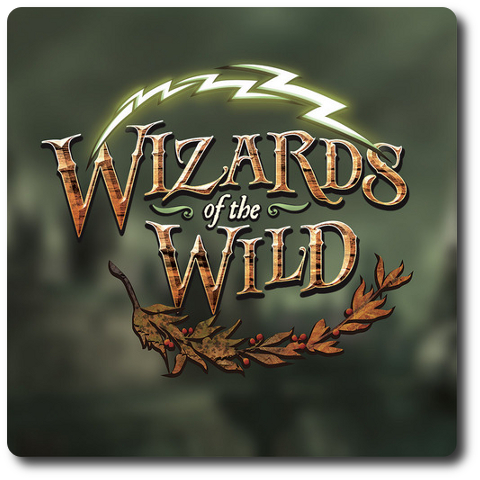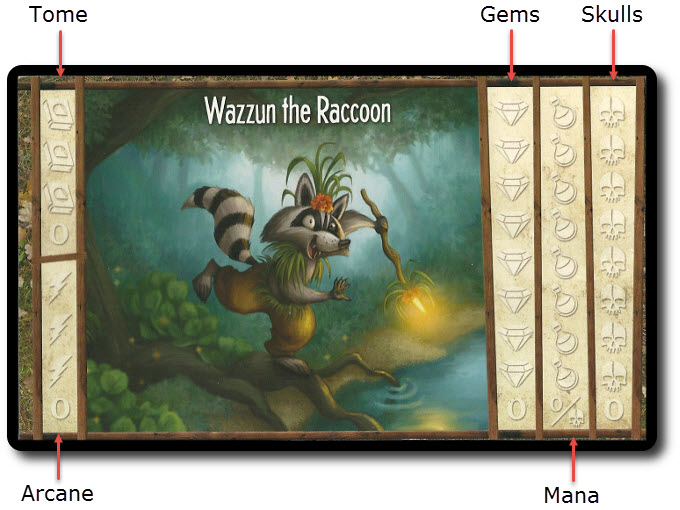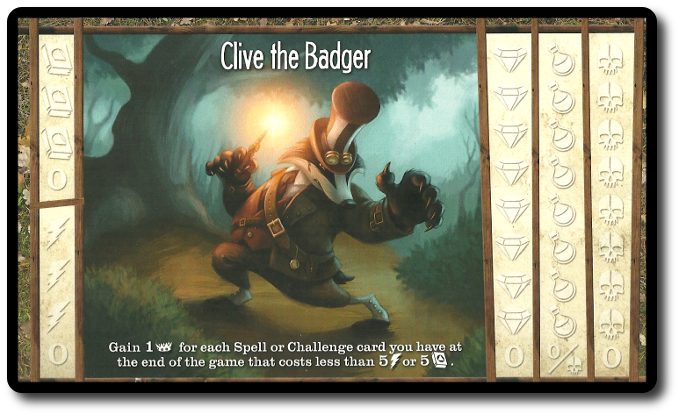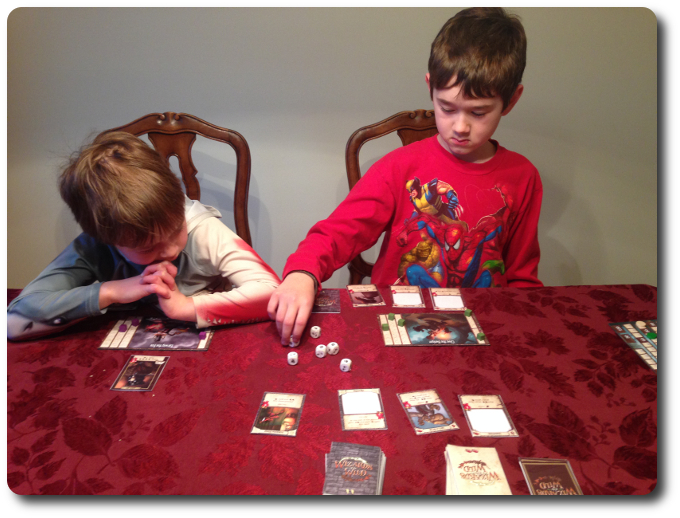Please Take Note: This is a review of the final game, but it might change slightly based on the success of the Kickstarter campaign. The game is being reviewed on the components and the rules provided with the understanding that “what you see is not what you might get” when the game is published. If you like what you read and want to learn more, we encourage you to visit the game publisher’s website or visit the Kickstarter campaign. Now that we have all that disclaimer junk out of the way, on with the review.

The Basics:
- For ages 10 and up
- For 2 to 4 players
- Approximately 30 minutes to complete
Geek Skills:
- Counting & Math
- Logical & Critical Decision Making
- Reading
- Pattern/Color Matching
- Strategy & Tactics
- Risk vs. Reward
- Hand/Resource Management
Learning Curve:
- Child – Easy
- Adult – Easy
Theme & Narrative:
- Magic isn’t cheap, but it can be had
Endorsements:
- Gamer Geek approved!
- Parent Geek approved!
- Child Geek approved!
Overview
In a remote region of the world there is an ancient circle of stones. There the talented and the foolhardy meet under the full moon to demonstrate their magical abilities. Some come to learn, but most come to dominate. In the world of magic, only the strong survive and flourish leaving the weak to bicker over whatever scraps of power remain. You have ventured to the circle of stones to prove your worth. Stepping into the circle, you see you are not alone.
Wizards of the Wild, designed by Dan Schnake, Adam West, and to be published by CrossCut Games, will reportedly be comprised of 6 Wizard player boards (double-sided), 1 score board, 32 wooden markers (in 4 different colors, 8 per color), 18 “Level One” Spell cards, 18 “Level Two” Spell cards, 18 “Level One” Challenge cards, 18 “Level Two” Challenge cards, 8 Acolyte cards, and 6 custom six-sided Sorcery dice. As this is a review of a prepublished game, I will not comment on the game component quality. The illustrations by Shawna J.C. Tenney do an excellent job of capturing the different personalities of the animal wizards and the world they live in. Good job, Shawna.
Game Set Up
To set up the game, first have each player select 1 Wizard player board of their choice. All the Wizard player boards are the same, so the only decision making here is based on animal preference. In our copy of the game, we had a badger in a top hat, a gypsy rabbit, a wise old owl, a cat in boots, a possibly insane raccoon, and a nefarious looking fox. Place any Wizard player boards not selected back in the game box. For now, place the Wizard player board so the side without any text is face-up. We’ll talk about the other side a little later.
The Wizard player board acts as a player’s personal “bank” during the game. Each column is reserved for a specific resource..

This raccoon isn’t right in the head…
Give each player the wooden markers in their color preference. Have each player place 1 marker on the “Tome” and “Arcane” tracks on the 2 space, the 3 space on the “Gems” track, the 4 space on the “Mana” track, and 1 on the 0 (zero) space on the “Skulls” track.
Third, place the score board to one side of the game playing area and within reach of at least 1 player. All players now place one of their markers on the 10 space on the score board. The remaining markers are set aside by the player who owns them. They will be used when the player’s score goes over 50 and 100 points.
Fourth, shuffle the “Level One” Spell and “Level One” Challenge cards separately. Make 2 draw piles for each, dealing out a number of cards to each pile based on the number of players in the game. For example, if playing with 4 players, 10 “Level One” Spell cards and 10 “Level One” Challenge cards will be dealt to the piles. Take each pile and place to one side of the game playing area, face-down. Unused “Level One” cards are removed for the rest of the game.
Fifth, take the “Level Two” Spell and “Level Two” Challenge cards, shuffle separately, and placed face-down next to the “Level One” cards. Place the “Level One” Spell card pile on top of the “Level Two” Spell card pile to form one Spell card draw deck. Do not reshuffle. Repeat the same steps for the “Level One” and “Level Two” Challenge card piles. The end result should be 2 draw decks. One for the Spell cards and one for the Challenge cards.
Sixth, draw 2 Spell cards and 2 Challenge cards and place them face-up. This is a market of sorts and where players will buy cards. For lack of a better name for it, we’ll call it the “Market”, although this term is not used in the game.
Seventh, shuffle the Acolyte cards and deal 7 face-down to a pile. This is the Acolyte draw deck for the duration of the game. Remove the undealt Acolyte card for the duration of the game.
That’s it for game set up. Determine who will be the first player and hand them the dice. Time to make some magic.
Wild Magic
We have already been introduced to our animal wizard, but know nothing yet of what they are capable of, what powers they seek, and the dangers they will undoubtedly face. Wizards of the Wild is a game that uses several different cards and dice to portray the action in the game and challenge the player. Each of the major game components are summarized here.
Spell Cards
The Spell cards represent the different incantations the player’s animal wizard can obtain, as well as use. There are two levels, but all Spell cards have the same layout. In total, there are 3 different schools of magic. These are Sorcery, Enchantment, and Shadow. Each school provides the wizard a good deal of power, but at a cost. For example, the school of Shadow magic is perfect for those players who want to directly impact an opponent’s game; however, doing so might penalize the player at the end of the game.
When a Spell card is purchased, is it placed in front of the player and is available to them when they need it. If the player wants to cast the spell, the Spell description is followed and resolved. Some spells can only be cast during certain times of the game while others can be cast “whenever”. But such power is not limitless. Each Spell card can only be used once per turn. I suggest players tip their Spell cards sideways after it has been used to indicate to the player and the player’s opponent’s that the spell is no longer available. This is important for two reasons. First, it helps keep everything organized. Second, Spell cards often provide power that can be used for other spells. Tipping them helps the player add up how many resources they have to spend and in what order.

Challenge Cards
Challenge cards represent actions the player’s wizard animal is taking or has taken. Honestly, the timeline here is a bit fuzzy. When a player purchases a Challenge card, the Challenge Effect is immediately triggered and resolved if possible. Once resolved, they are flipped face-down and left in front of the player for later use at the end of the game. There are a few Challenge cards that do not trigger until the end of the game. These are left face-up to remind the player that they have unfinished business.

Acolyte Cards
The Acolytes are mysterious and powerful. They are also completely and totally corrupt. They are judge, jury, and executioner if need be and they are not above taking a bribe. Consider by many to be the most powerful magic users in the world, the players will quickly learn that Acolytes are more of a penalty as they are a bonus. Regardless, the players must deal with each Acolyte at least once while in the circle of stones.
An Acolyte will reduce the amount of Mana (the stuff that makes magic possible) available to each player, gladly take bribe from a player in exchange for some victory points, and will penalize any player who has too many Skulls. Some say that Acolytes help create balance, but that might be pushing it. An Acolyte is a roadblock. It’s up to the player to avoid it or jump over it.

Conjuring, Incantations, and a Deadly Challenge
Wizards of the Wild is played in 7 rounds. During each round, players will take turns. When all the players have completed their turn, the round ends and a new round begins. A player’s turn is summarized here.
Before each round of game play, draw a new Acolyte card. This Acolyte is active for the entire round. Any Mana Penalty listed is immediately in effect for all players.
Step 1: Fill Market
This step is referred to as “fill display” in the game rules, which uses terminology that confused a number of our players. That’s why we started referring to it as the “Market”. If there are less than 4 cards face-up, the player may draw from either the Spell draw deck or the Challenge draw deck as many times as they like until the total number of cards face-up and available for purchase is 4.
Step 2: Roll Dice
The player now takes all the Sorcery dice and rolls them. The possible values are as follows:

- Arcane is used to buy Challenge cards.
- Tomes are used to buy Spell cards.
- Arcane/Tome rolls allow the player to choose if they want the Arcane or the Tome, not both.
- Mana powers the Spell cards. For every Mana result rolled, the player collects 2 Mana to use. Players need to watch their Mana levels closely. If a player is required to spend Mana and cannot, they will be penalized by taking Skulls.
- Gems are used to bribe the Acolytes and serve as necessary components for some Spell cards.
- Skulls are a double-edge sword. They are used to power some very nasty spells, but they can cost the player the game if they have too many at the end.
After the player’s first roll, they can re-roll any dice they like. The player can re-roll a total of 2 times on their turn, setting aside any dice they want to keep and re-rolling those they don’t. Once done, the dice are placed in front of the player and are resolved by taking several optional actions.
Step 3: Optional Actions
The player can take any of the following optional actions, some, or none. What actions they take will depend a great deal on the dice values rolled.
Buy Cards
Any of the face-up cards in the Market are available for purchase. The player spends the Arcane and Tome die roll results to purchase the Challenge or Spell cards they want. The cost of each card is listed in the corner. Players can also spend their “banked” Arcane and Tomes if they like during this time. One purchased, it’s placed in front of the player. Sometimes the card will trigger immediately and must be resolved before the player can continue their turn. Sometimes the card will stay in front of the player until later in the game.
When a card is purchased, it’s not replaced at this time. This means a player will only ever have 4 cards to review and possibly buy.
Use Cards
For those Challenge and Spell cards that were not triggered upon purchase, the player can now activate those they have in front of them and are available. The player spends the appropriate dice to pay for the Spell or the Challenge card and then resolves the card’s effects accordingly. If necessary, the player can use any “banked” resources that are required.
Store Resources
Any die values not spent can be saved for later. These values are recorded as a resource and kept track of on the Wizard player board. Each resource has a maximum cap that cannot be exceeded. Use the markers to help keep track of the total number of each resource stored for later use.
Step 4: Optionally Bribe the Acolyte
Before the player’s turn is over, they can optionally bribe the currently available Acolyte. The Acolyte cards lists what the Acolyte wants and what the Acolyte will provide in return. Bribing is completely optional and is not always in the player’s best interest.
This completes the player’s turn. The next player in turn order sequence now goes starting with step 1 noted above.
Ending the Round and Completing the Game
When the round ends, the Acolyte Skull Penalty is resolved. The player with the most Skulls reduces their victory points per the penalty value listed and then the Acolyte is discarded. The next round can now being. The player who went last this round gets to go first in the next round.
After the 7th round, the game is almost over. Final scoring now begins by first counting all the victory points earned from purchased Spell cards and then Challenge cards. The total number of victory points earned are recorded on the score board. The player with the most victory points wins the game and is truly the greatest wizard of the wild.
Game Variant
The Wizard player boards are double-sided. One side just displays the image of the animal wizard the player selected. The other side lists a special power that is unique to the Wizard player board. This gives each player a special tactic only they have access to. The player is welcome to use it, building a strategy around the special ability, or completely ignore it. If the special abilities are going to be used, I suggest you randomly distribution the Wizard player boards during game set up. Game set up is the same and use of the special abilities is based on when they are triggered.

To learn more about Wizards of the Wild, visit the game publisher’s website or visit the Kickstarter campaign.
Final Word
The Child Geeks were off to a slow start. They understood the game’s most basic game play. Rolling dice, keeping values, and buying cards all came naturally to them. What they did not grasp for at least the first and sometimes not until after the second game, was the need to build a collection of Spell and Challenge cards that allowed the player to continually score victory points. Failure to do so cost a number of the Child Geeks the game and kept victory points low. After a few games, however, the Child Geeks realized that they needed to spend less time waiting to buy spells that sounded cool and focus more on building combos and multiple card abilities that triggered and fed off each other. When they did, their games greatly improved and so too did their level of enjoyment. According to one Child Geek, “This games has everything I love. The dice, the cards, the magic. It’s got it all. It reminds me of Magic: The Gathering, except with badgers and other animals.” Another Child Geek said, “This game was hard at first. It’s still heard, but at least now I know what I’m doing and I’m having a blast.” All the Child Geeks voted to approve Wizards of the Wild, but not at first. This was a game they slowly warmed up to, and when they did, it was nothing but love.

My oldest organizes his dice while his younger magical brother looks on…
The Parent Geeks understood the easiest and the most complicated aspects of the game almost immediately. What none of them were prepared for was how fast the game played. One Parent Geek said, “Wait! What? It’s over? No! I haven’t done what I wanted to do yet!” It was the speed of the game that threw a lot of the Parent Geeks off at first, finding it sometimes impossible to purchase the right cards and make the right combos in time before the final round was played out. According to one Parent Geek, “This is a great game, but wow, challenging. You have to be really focused and have a good idea of what you want to do before you even set up the game.” The non-gamers found Wizards of the Wild to be a bit too much for them and decide to reject it, but the vast majority of the Parent Geeks voted to approve it.
The Gamer Geeks were impressed with how streamlined the game played, thought the Acolytes were more trouble than what they were worthy, and very much enjoyed the challenge of creating their “engine” with Spell and Challenge cards in such a short amount of time. One Gamer Geek said, “A neat game. It combines deck building, resource management, risk versus reward, and logical thinking in a great way.” Neat, but not unique. A number of the Gamer Geeks found Wizards of the Wild to be a jumble of other games all thrown in together. As one Gamer Geek put it, “This game is a potpourri of others and given a new title. Nothing new here, but it all works well.” Lack of originality hurt the game a bit with the Gamer Geeks who tend to frown when games are not innovating, but none of them could say that Wizards of the Wild was a bad game. While the level of enjoyment was different, ranging from “OK” to “great”, all the Gamer Geeks voted to approve Wizards of the Wild.
Wizards of Wild combines several types of game play that many enjoyed, including myself. The use of dice is reminiscent of King of Tokyo where what values you roll powers what you can do during your round. The simple, yet strangely heavy, resource management in the game creates a very satisfying sense of organization and involvement. The Spell cards are worthless individually, but a player will quickly come to understand that each Spell card is a link in the chain. How strong the player’s chain is will be based on what Spell cards they collect. It’s very possible to create a formidable engine of cards that constantly generates enough power to conquer all. Finally, the Challenge cards are like icing on the proverbial cake. They give the player a one time bonus or jab that can be used to temporarily boost them or temporarily set an opponent back.
The only card in the game that was believed to be the least important was the Acolyte card. They have their use, however. They keep track of the number of rounds played and the number left. They also flip the table on the players by penalizing and rewarding at the same time. The Acolyte cards might be the least popular, but they have the most impact on the game over all. They keep the game in a state of flux, requiring the most organized of players to always be on the lookout for the unknown.
Wizards of the Wild is small, but plays big. Game play is quick, but you’ll gladly use more time than what is probably necessary to make some choices. Luckily, no player should suffer more than a minute or two of analysis paralysis. The number of dice resources are limited and a player only ever has 4 cards to buy. Based on the dice rolls and what resources they have banked, what cards the player should or can purchase might be a very easy decision.
In fact, the game actually becomes more complicated and takes longer as you approach the end. The more Spell cards the player has, the more forks in the road they come to. If a player purchases a wide variety of Spell cards, the number of options they can take will start to get confusing. This is why it’s so important for a player to make logical and critical decisions when it comes to purchasing cards. A player can create a very formidable engine, but they can get lost in the details, as well.
All our games took 30 minutes or slightly less, challenged our players, and entertained them. Some more than others, but most felt that the game did it’s job and was worth their time. The game is easy to teach, easy to play, but can be downright tricky to win. The goal is to score victory points every round and to do that you need to purchase cards that always return more than what you spend. And there in lies the real magic “trick” of the game. If this sounds like the kind of game you’d like to play, then do sit down and play Wizards of the Wild.
This is a paid for review of the game’s final prototype. Although our time and focus was financially compensated, our words are our own. We’d need at least 10 million dollars before we started saying what other people wanted. Such is the statuesque and legendary integrity of Father Geek which cannot be bought except by those who own their own private islands and small countries.



